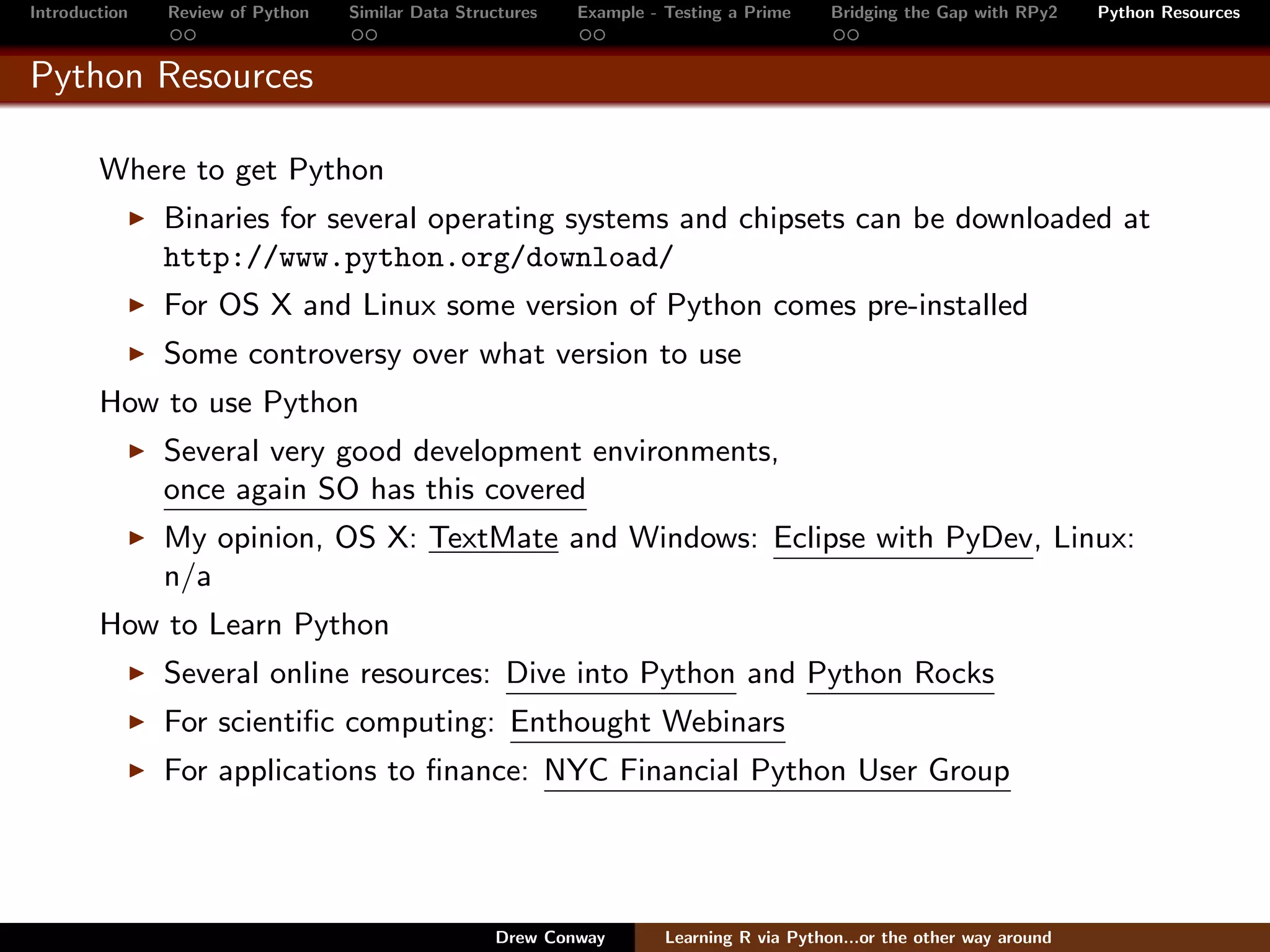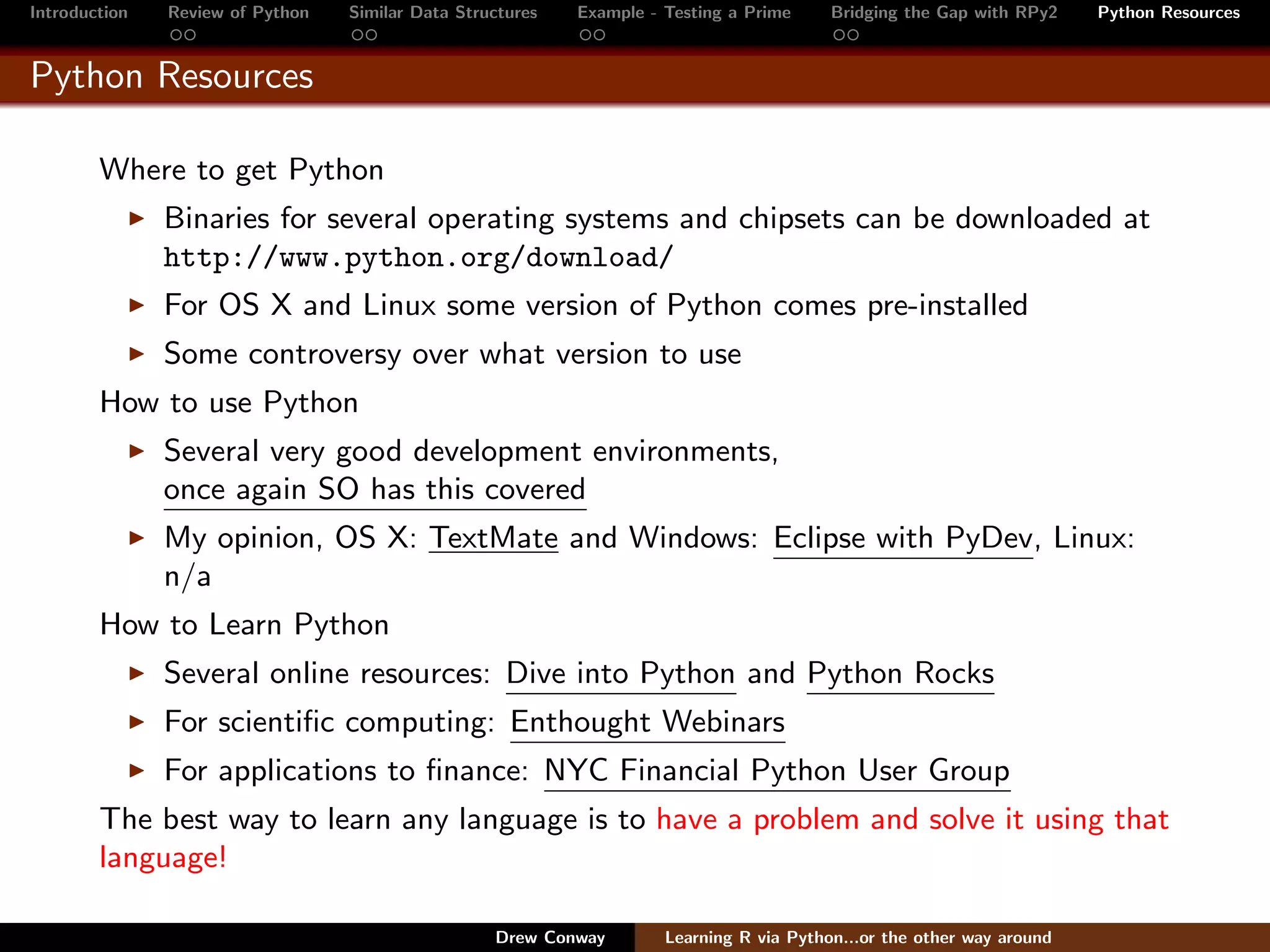The document discusses similarities and differences between R and Python programming languages. Both support functional and object-oriented programming paradigms. However, Python is designed more for general application development while R focuses on data analysis functions. Their syntax also differs, with Python emphasizing readability through whitespace and R favoring brevity through nesting. Examples are provided to demonstrate equivalent functionality in each language.
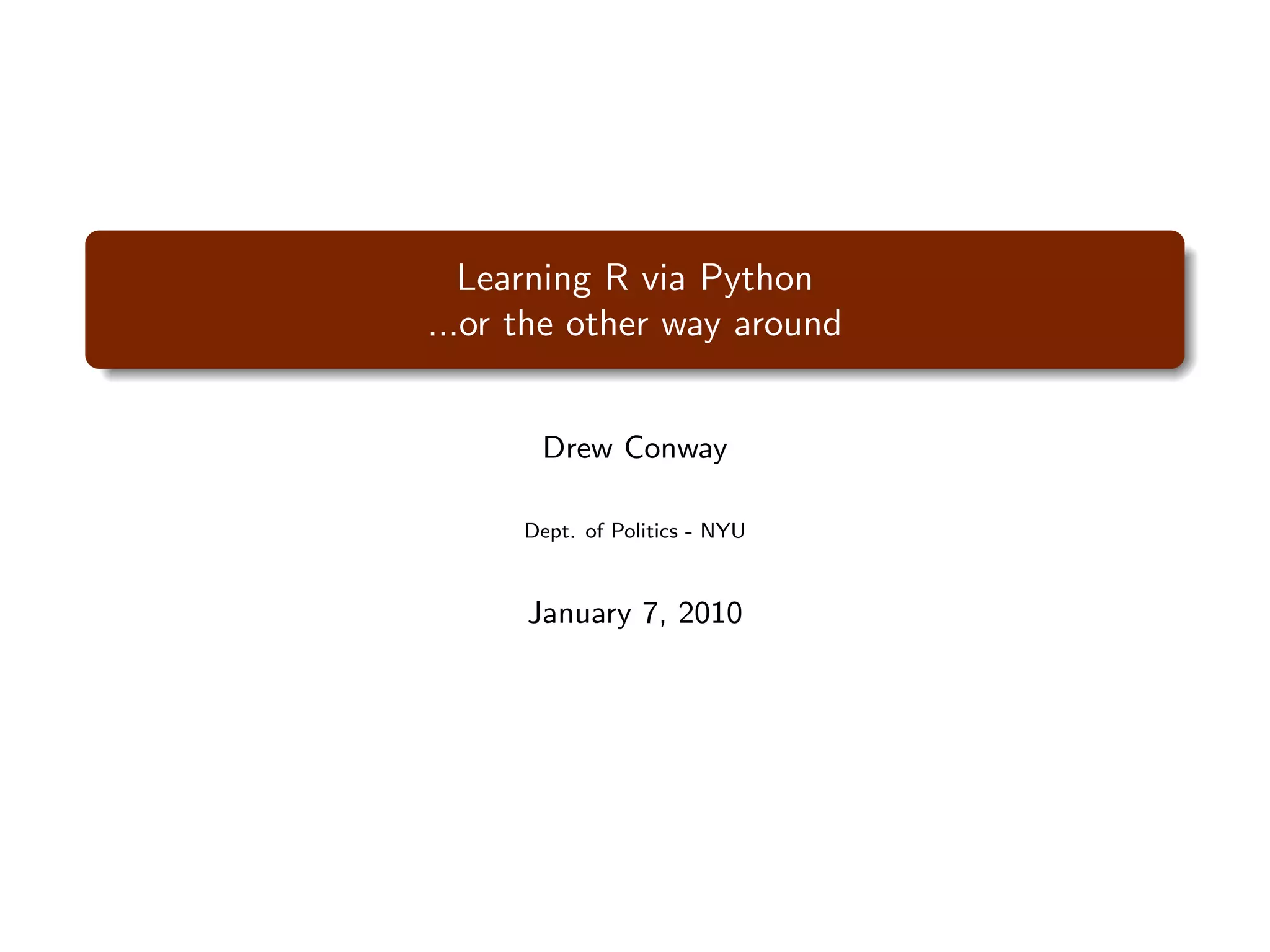
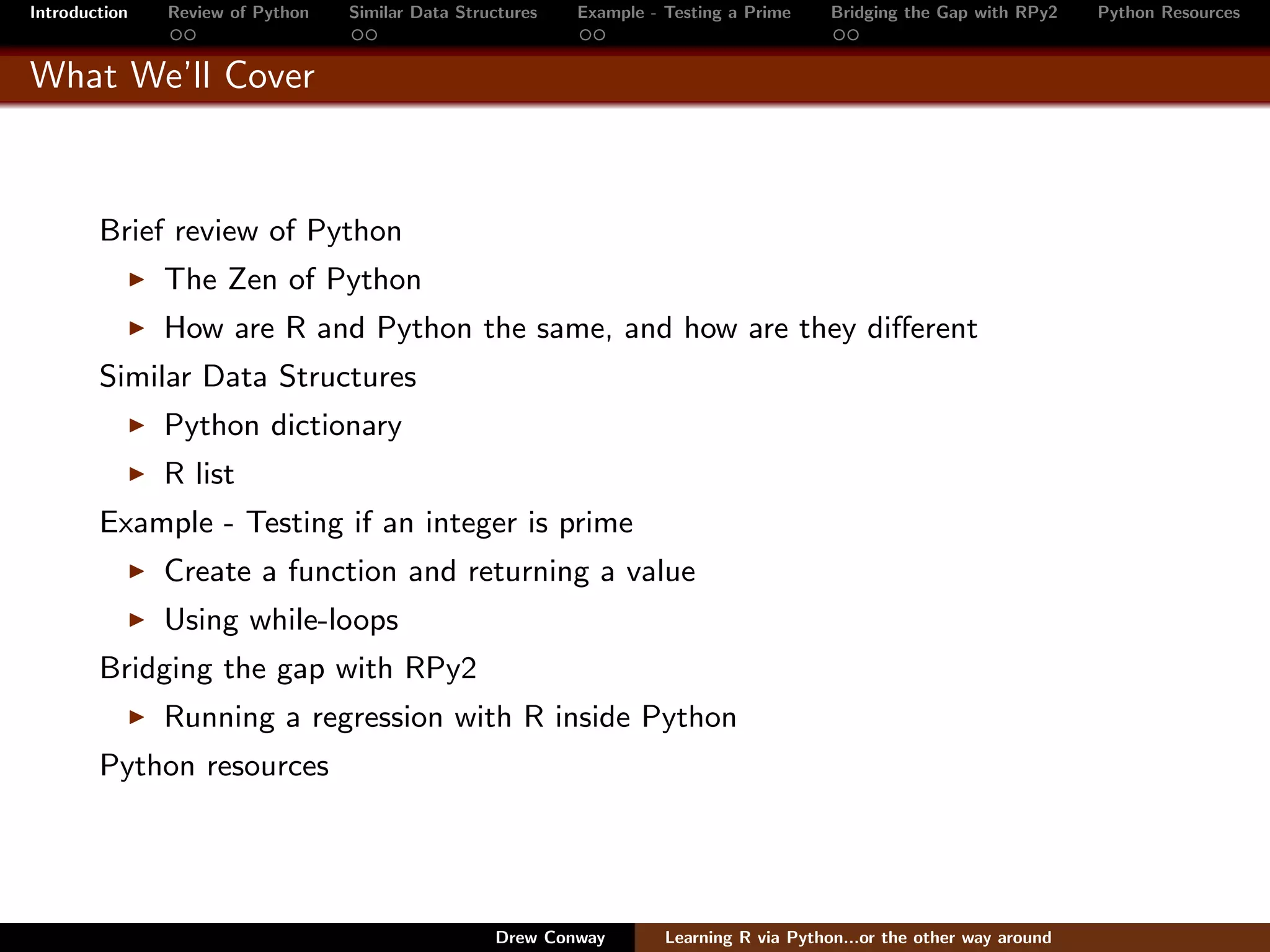
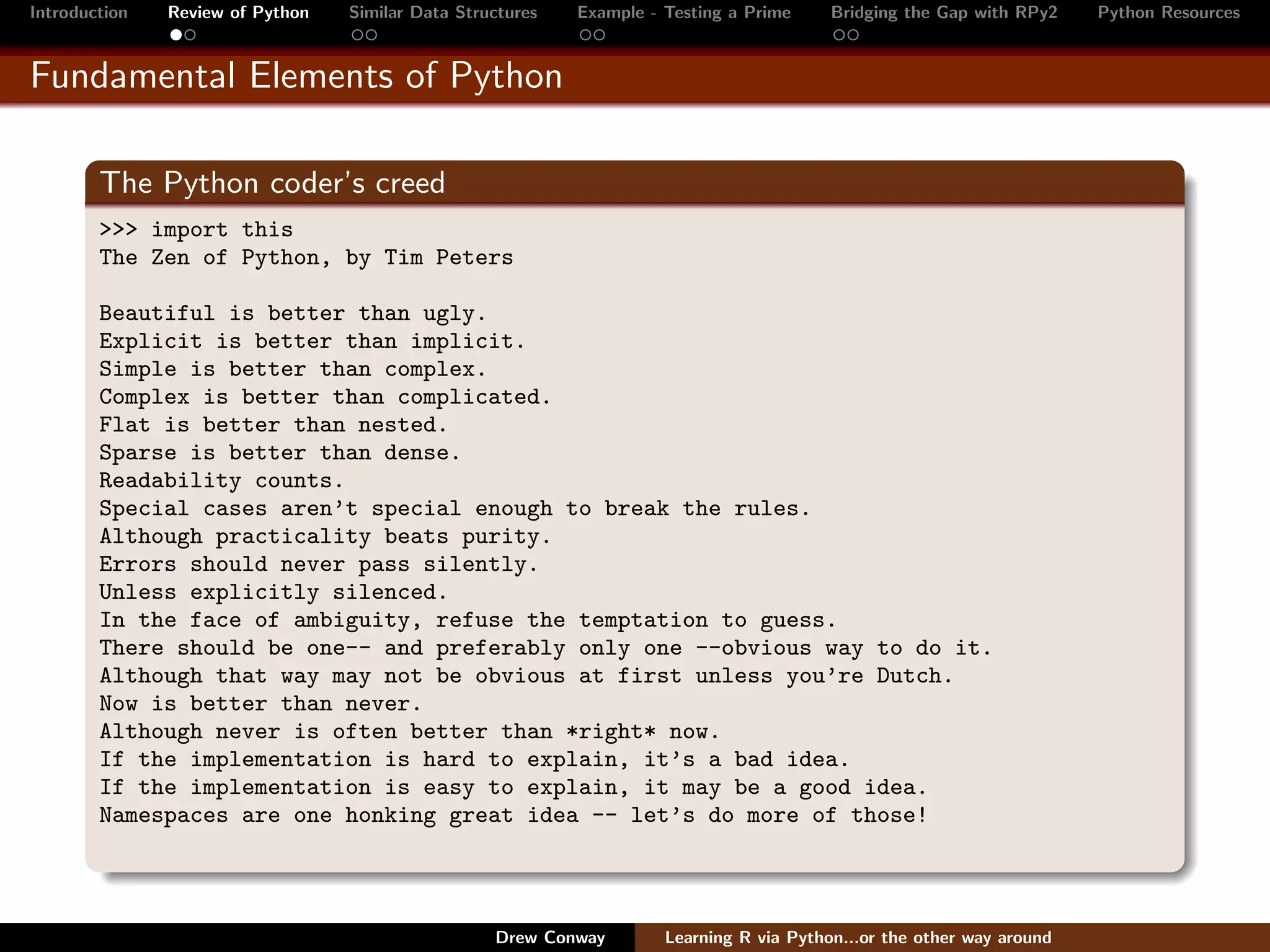
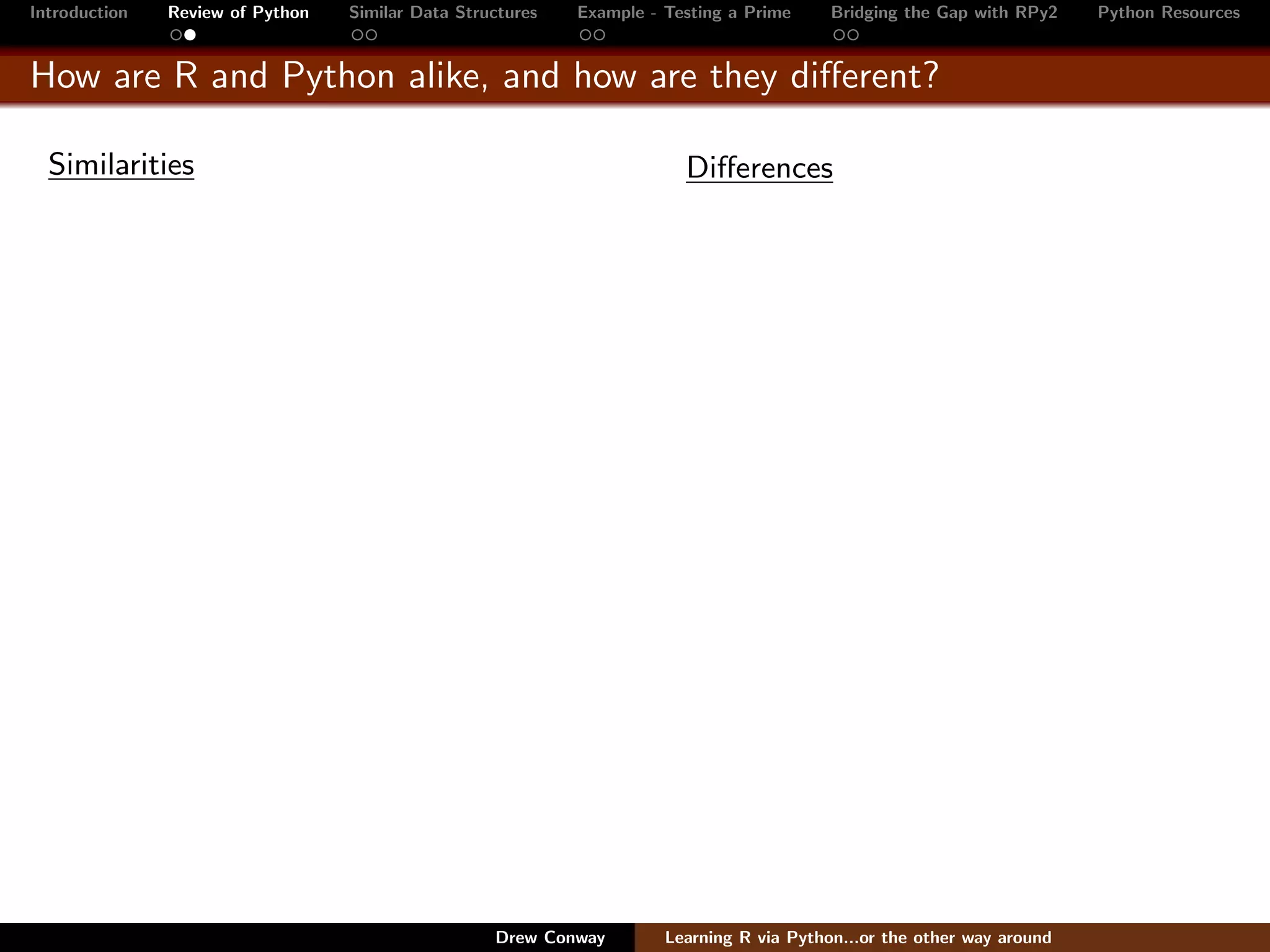
![Introduction Review of Python Similar Data Structures Example - Testing a Prime Bridging the Gap with RPy2 Python Resources
How are R and Python alike, and how are they different?
Similarities Differences
Functional programming paradigm
Array of squared values
# In Python we use a lambda nested in map
>>> map(lambda x: x**2,range(1,11))
[1, 4, 9, 16, 25, 36, 49, 64, 81, 100]
Drew Conway Learning R via Python...or the other way around](https://image.slidesharecdn.com/pythonrrs-110318195139-phpapp02/75/Learning-R-via-Python-or-the-other-way-around-5-2048.jpg)
![Introduction Review of Python Similar Data Structures Example - Testing a Prime Bridging the Gap with RPy2 Python Resources
How are R and Python alike, and how are they different?
Similarities Differences
Functional programming paradigm
Array of squared values
# In Python we use a lambda nested in map
>>> map(lambda x: x**2,range(1,11))
[1, 4, 9, 16, 25, 36, 49, 64, 81, 100]
# In R we define a function in sapply
> sapply(1:10,function(x){return(x**2)})
[1] 1 4 9 16 25 36 49 64 81 100
Drew Conway Learning R via Python...or the other way around](https://image.slidesharecdn.com/pythonrrs-110318195139-phpapp02/75/Learning-R-via-Python-or-the-other-way-around-6-2048.jpg)
![Introduction Review of Python Similar Data Structures Example - Testing a Prime Bridging the Gap with RPy2 Python Resources
How are R and Python alike, and how are they different?
Similarities Differences
Functional programming paradigm
Array of squared values
# In Python we use a lambda nested in map
>>> map(lambda x: x**2,range(1,11))
[1, 4, 9, 16, 25, 36, 49, 64, 81, 100]
# In R we define a function in sapply
> sapply(1:10,function(x){return(x**2)})
[1] 1 4 9 16 25 36 49 64 81 100
Object-oriented programming
Both languages support robust class
structures
In R, there are the S3 and S4 classes
Drew Conway Learning R via Python...or the other way around](https://image.slidesharecdn.com/pythonrrs-110318195139-phpapp02/75/Learning-R-via-Python-or-the-other-way-around-7-2048.jpg)
![Introduction Review of Python Similar Data Structures Example - Testing a Prime Bridging the Gap with RPy2 Python Resources
How are R and Python alike, and how are they different?
Similarities Differences
Functional programming paradigm
Array of squared values
# In Python we use a lambda nested in map
>>> map(lambda x: x**2,range(1,11))
[1, 4, 9, 16, 25, 36, 49, 64, 81, 100]
# In R we define a function in sapply
> sapply(1:10,function(x){return(x**2)})
[1] 1 4 9 16 25 36 49 64 81 100
Object-oriented programming
Both languages support robust class
structures
In R, there are the S3 and S4 classes
Easily call C/Fortran code
Due to their high-level, both languages
provide functionality to call compiled code
from lower-level languages
Drew Conway Learning R via Python...or the other way around](https://image.slidesharecdn.com/pythonrrs-110318195139-phpapp02/75/Learning-R-via-Python-or-the-other-way-around-8-2048.jpg)
![Introduction Review of Python Similar Data Structures Example - Testing a Prime Bridging the Gap with RPy2 Python Resources
How are R and Python alike, and how are they different?
Similarities Differences
Functional programming paradigm General purpose OOP vs. Functional OOP
Python is a high-level language for
Array of squared values
application development
# In Python we use a lambda nested in map
>>> map(lambda x: x**2,range(1,11)) R is a collection of functions for data
[1, 4, 9, 16, 25, 36, 49, 64, 81, 100] analysis
# In R we define a function in sapply
> sapply(1:10,function(x){return(x**2)})
[1] 1 4 9 16 25 36 49 64 81 100
Object-oriented programming
Both languages support robust class
structures
In R, there are the S3 and S4 classes
Easily call C/Fortran code
Due to their high-level, both languages
provide functionality to call compiled code
from lower-level languages
Drew Conway Learning R via Python...or the other way around](https://image.slidesharecdn.com/pythonrrs-110318195139-phpapp02/75/Learning-R-via-Python-or-the-other-way-around-9-2048.jpg)
![Introduction Review of Python Similar Data Structures Example - Testing a Prime Bridging the Gap with RPy2 Python Resources
How are R and Python alike, and how are they different?
Similarities Differences
Functional programming paradigm General purpose OOP vs. Functional OOP
Python is a high-level language for
Array of squared values
application development
# In Python we use a lambda nested in map
>>> map(lambda x: x**2,range(1,11)) R is a collection of functions for data
[1, 4, 9, 16, 25, 36, 49, 64, 81, 100] analysis
# In R we define a function in sapply Syntax structure
> sapply(1:10,function(x){return(x**2)})
[1] 1 4 9 16 25 36 49 64 81 100 Python syntax forces readability
through whitespace
R emphasizes parsimony and nesting
Object-oriented programming
Both languages support robust class
structures
In R, there are the S3 and S4 classes
Easily call C/Fortran code
Due to their high-level, both languages
provide functionality to call compiled code
from lower-level languages
Drew Conway Learning R via Python...or the other way around](https://image.slidesharecdn.com/pythonrrs-110318195139-phpapp02/75/Learning-R-via-Python-or-the-other-way-around-10-2048.jpg)
![Introduction Review of Python Similar Data Structures Example - Testing a Prime Bridging the Gap with RPy2 Python Resources
How are R and Python alike, and how are they different?
Similarities Differences
Functional programming paradigm General purpose OOP vs. Functional OOP
Python is a high-level language for
Array of squared values
application development
# In Python we use a lambda nested in map
>>> map(lambda x: x**2,range(1,11)) R is a collection of functions for data
[1, 4, 9, 16, 25, 36, 49, 64, 81, 100] analysis
# In R we define a function in sapply Syntax structure
> sapply(1:10,function(x){return(x**2)})
[1] 1 4 9 16 25 36 49 64 81 100 Python syntax forces readability
through whitespace
R emphasizes parsimony and nesting
Object-oriented programming
Both languages support robust class Creating a function
structures
In R, there are the S3 and S4 classes # In Python functions are declared
>>> def my func(x):
Easily call C/Fortran code ...
Due to their high-level, both languages
provide functionality to call compiled code
from lower-level languages
Drew Conway Learning R via Python...or the other way around](https://image.slidesharecdn.com/pythonrrs-110318195139-phpapp02/75/Learning-R-via-Python-or-the-other-way-around-11-2048.jpg)
![Introduction Review of Python Similar Data Structures Example - Testing a Prime Bridging the Gap with RPy2 Python Resources
How are R and Python alike, and how are they different?
Similarities Differences
Functional programming paradigm General purpose OOP vs. Functional OOP
Python is a high-level language for
Array of squared values
application development
# In Python we use a lambda nested in map
>>> map(lambda x: x**2,range(1,11)) R is a collection of functions for data
[1, 4, 9, 16, 25, 36, 49, 64, 81, 100] analysis
# In R we define a function in sapply Syntax structure
> sapply(1:10,function(x){return(x**2)})
[1] 1 4 9 16 25 36 49 64 81 100 Python syntax forces readability
through whitespace
R emphasizes parsimony and nesting
Object-oriented programming
Both languages support robust class Creating a function
structures
In R, there are the S3 and S4 classes # In Python functions are declared
>>> def my func(x):
Easily call C/Fortran code ...
Due to their high-level, both languages # In R functions are assigned
> my.func<-function(x) { ... }
provide functionality to call compiled code
from lower-level languages
Drew Conway Learning R via Python...or the other way around](https://image.slidesharecdn.com/pythonrrs-110318195139-phpapp02/75/Learning-R-via-Python-or-the-other-way-around-12-2048.jpg)
![Introduction Review of Python Similar Data Structures Example - Testing a Prime Bridging the Gap with RPy2 Python Resources
How are R and Python alike, and how are they different?
Similarities Differences
Functional programming paradigm General purpose OOP vs. Functional OOP
Python is a high-level language for
Array of squared values
application development
# In Python we use a lambda nested in map
>>> map(lambda x: x**2,range(1,11)) R is a collection of functions for data
[1, 4, 9, 16, 25, 36, 49, 64, 81, 100] analysis
# In R we define a function in sapply Syntax structure
> sapply(1:10,function(x){return(x**2)})
[1] 1 4 9 16 25 36 49 64 81 100 Python syntax forces readability
through whitespace
R emphasizes parsimony and nesting
Object-oriented programming
Both languages support robust class Creating a function
structures
In R, there are the S3 and S4 classes # In Python functions are declared
>>> def my func(x):
Easily call C/Fortran code ...
Due to their high-level, both languages # In R functions are assigned
> my.func<-function(x) { ... }
provide functionality to call compiled code
from lower-level languages
For more info see: StackOverlow.com discussion on topic
Drew Conway Learning R via Python...or the other way around](https://image.slidesharecdn.com/pythonrrs-110318195139-phpapp02/75/Learning-R-via-Python-or-the-other-way-around-13-2048.jpg)
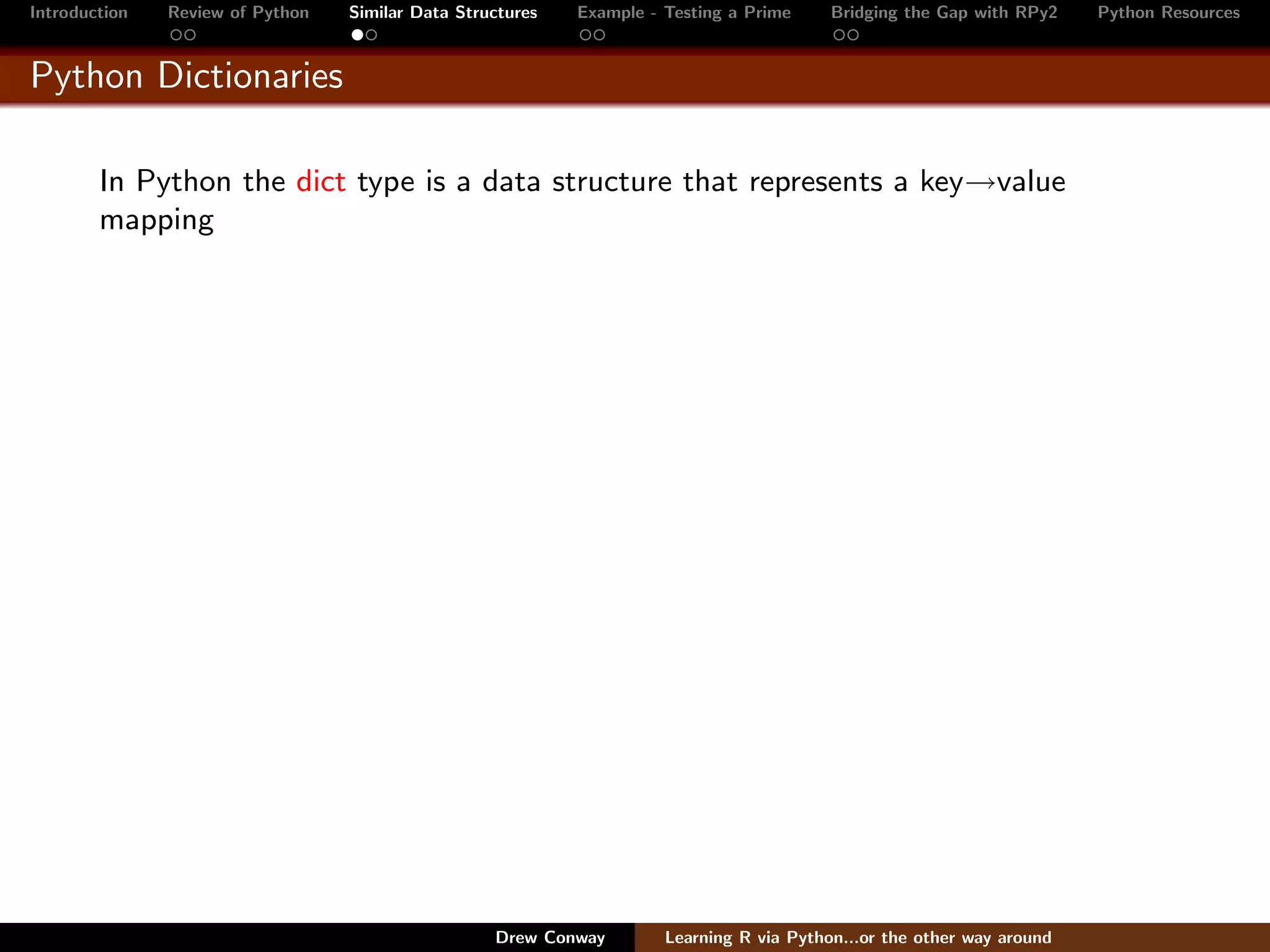
![Introduction Review of Python Similar Data Structures Example - Testing a Prime Bridging the Gap with RPy2 Python Resources
Python Dictionaries
In Python the dict type is a data structure that represents a key→value
mapping
Working with the dict type
# Keys and values can be of any data type
>>> fruit dict={"apple":1,"orange":[0.23,0.11],"banana":True }
Drew Conway Learning R via Python...or the other way around](https://image.slidesharecdn.com/pythonrrs-110318195139-phpapp02/75/Learning-R-via-Python-or-the-other-way-around-15-2048.jpg)
![Introduction Review of Python Similar Data Structures Example - Testing a Prime Bridging the Gap with RPy2 Python Resources
Python Dictionaries
In Python the dict type is a data structure that represents a key→value
mapping
Working with the dict type
# Keys and values can be of any data type
>>> fruit dict={"apple":1,"orange":[0.23,0.11],"banana":True }
# Can retrieve the keys and values as Python lists (vector)
>>> fruit dict.keys()
["orange","apple","banana"]
Drew Conway Learning R via Python...or the other way around](https://image.slidesharecdn.com/pythonrrs-110318195139-phpapp02/75/Learning-R-via-Python-or-the-other-way-around-16-2048.jpg)
![Introduction Review of Python Similar Data Structures Example - Testing a Prime Bridging the Gap with RPy2 Python Resources
Python Dictionaries
In Python the dict type is a data structure that represents a key→value
mapping
Working with the dict type
# Keys and values can be of any data type
>>> fruit dict={"apple":1,"orange":[0.23,0.11],"banana":True }
# Can retrieve the keys and values as Python lists (vector)
>>> fruit dict.keys()
["orange","apple","banana"]
# Or create a (key,value) tuple
>>> fruit dict.items()
[("orange",[0.23,0.11]),("apple",1),("Banana",True)]
Drew Conway Learning R via Python...or the other way around](https://image.slidesharecdn.com/pythonrrs-110318195139-phpapp02/75/Learning-R-via-Python-or-the-other-way-around-17-2048.jpg)
![Introduction Review of Python Similar Data Structures Example - Testing a Prime Bridging the Gap with RPy2 Python Resources
Python Dictionaries
In Python the dict type is a data structure that represents a key→value
mapping
Working with the dict type
# Keys and values can be of any data type
>>> fruit dict={"apple":1,"orange":[0.23,0.11],"banana":True }
# Can retrieve the keys and values as Python lists (vector)
>>> fruit dict.keys()
["orange","apple","banana"]
# Or create a (key,value) tuple
>>> fruit dict.items()
[("orange",[0.23,0.11]),("apple",1),("Banana",True)]
# This becomes especially useful when you master Python ‘‘list comprehension’’
Drew Conway Learning R via Python...or the other way around](https://image.slidesharecdn.com/pythonrrs-110318195139-phpapp02/75/Learning-R-via-Python-or-the-other-way-around-18-2048.jpg)
![Introduction Review of Python Similar Data Structures Example - Testing a Prime Bridging the Gap with RPy2 Python Resources
Python Dictionaries
In Python the dict type is a data structure that represents a key→value
mapping
Working with the dict type
# Keys and values can be of any data type
>>> fruit dict={"apple":1,"orange":[0.23,0.11],"banana":True }
# Can retrieve the keys and values as Python lists (vector)
>>> fruit dict.keys()
["orange","apple","banana"]
# Or create a (key,value) tuple
>>> fruit dict.items()
[("orange",[0.23,0.11]),("apple",1),("Banana",True)]
# This becomes especially useful when you master Python ‘‘list comprehension’’
The Python dictionary is an extremely flexible and useful data structure,
making it one of the primary advantages of Python over other languages
Luckily, there is a fairly direct mapping between the Python dict and R
lists!
Drew Conway Learning R via Python...or the other way around](https://image.slidesharecdn.com/pythonrrs-110318195139-phpapp02/75/Learning-R-via-Python-or-the-other-way-around-19-2048.jpg)
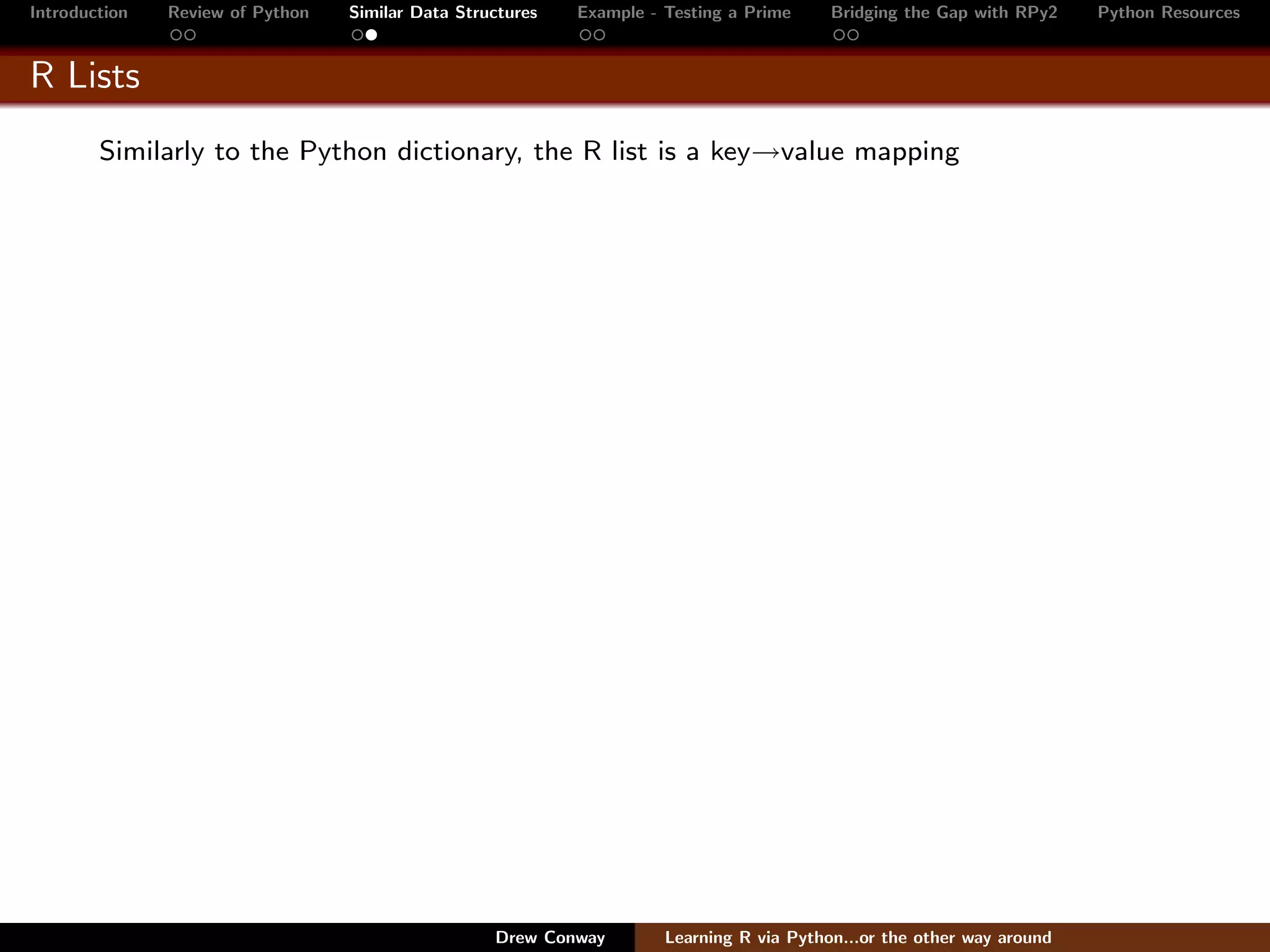
![Introduction Review of Python Similar Data Structures Example - Testing a Prime Bridging the Gap with RPy2 Python Resources
R Lists
Similarly to the Python dictionary, the R list is a key→value mapping
Working with an R list
> fruit.list<-list("apple"=1,"orange"=c(0.23,0.11),"banana"=TRUE)
> fruit.list
$apple
[1] 1
$orange
[1] 0.55 0.11
$banana
[1] TRUE
Drew Conway Learning R via Python...or the other way around](https://image.slidesharecdn.com/pythonrrs-110318195139-phpapp02/75/Learning-R-via-Python-or-the-other-way-around-21-2048.jpg)
![Introduction Review of Python Similar Data Structures Example - Testing a Prime Bridging the Gap with RPy2 Python Resources
R Lists
Similarly to the Python dictionary, the R list is a key→value mapping
Working with an R list
> fruit.list<-list("apple"=1,"orange"=c(0.23,0.11),"banana"=TRUE)
> fruit.list
$apple
[1] 1
$orange
[1] 0.55 0.11
$banana
[1] TRUE
Notice, however, that R will always treat the value of the key/value pair as a vector;
unlike Python, which does not care the value’s data type. Of the many R
programming paradigms, the “vectorization of all data” is among the strongest.
Drew Conway Learning R via Python...or the other way around](https://image.slidesharecdn.com/pythonrrs-110318195139-phpapp02/75/Learning-R-via-Python-or-the-other-way-around-22-2048.jpg)
![Introduction Review of Python Similar Data Structures Example - Testing a Prime Bridging the Gap with RPy2 Python Resources
R Lists
Similarly to the Python dictionary, the R list is a key→value mapping
Working with an R list
> fruit.list<-list("apple"=1,"orange"=c(0.23,0.11),"banana"=TRUE)
> fruit.list
$apple
[1] 1
$orange
[1] 0.55 0.11
$banana
[1] TRUE
Notice, however, that R will always treat the value of the key/value pair as a vector;
unlike Python, which does not care the value’s data type. Of the many R
programming paradigms, the “vectorization of all data” is among the strongest.
Using unlist
> unlist(fruist.list)
apple orange1 orange2 banana
1.00 0.55 0.11 1.00
Drew Conway Learning R via Python...or the other way around](https://image.slidesharecdn.com/pythonrrs-110318195139-phpapp02/75/Learning-R-via-Python-or-the-other-way-around-23-2048.jpg)
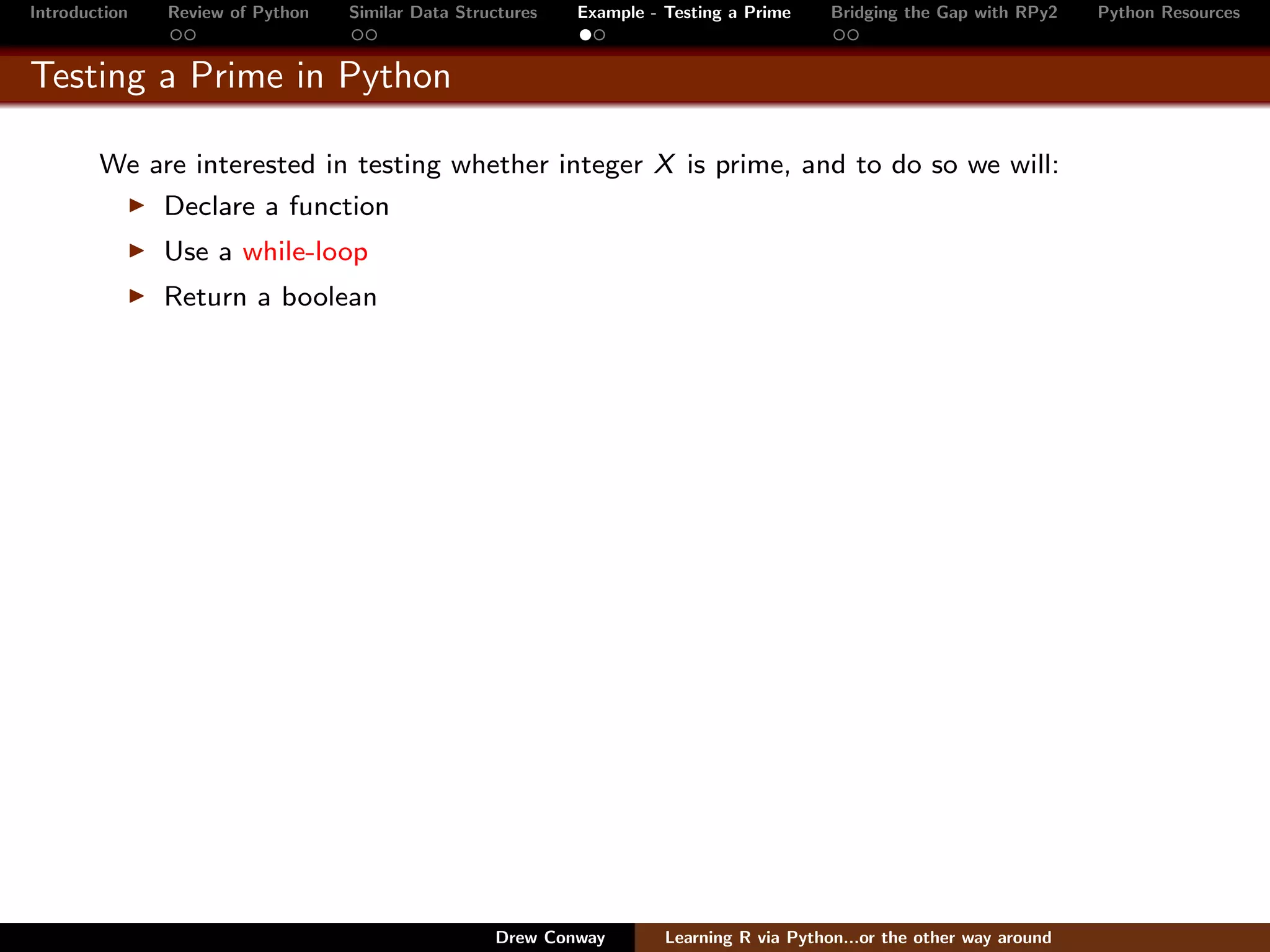
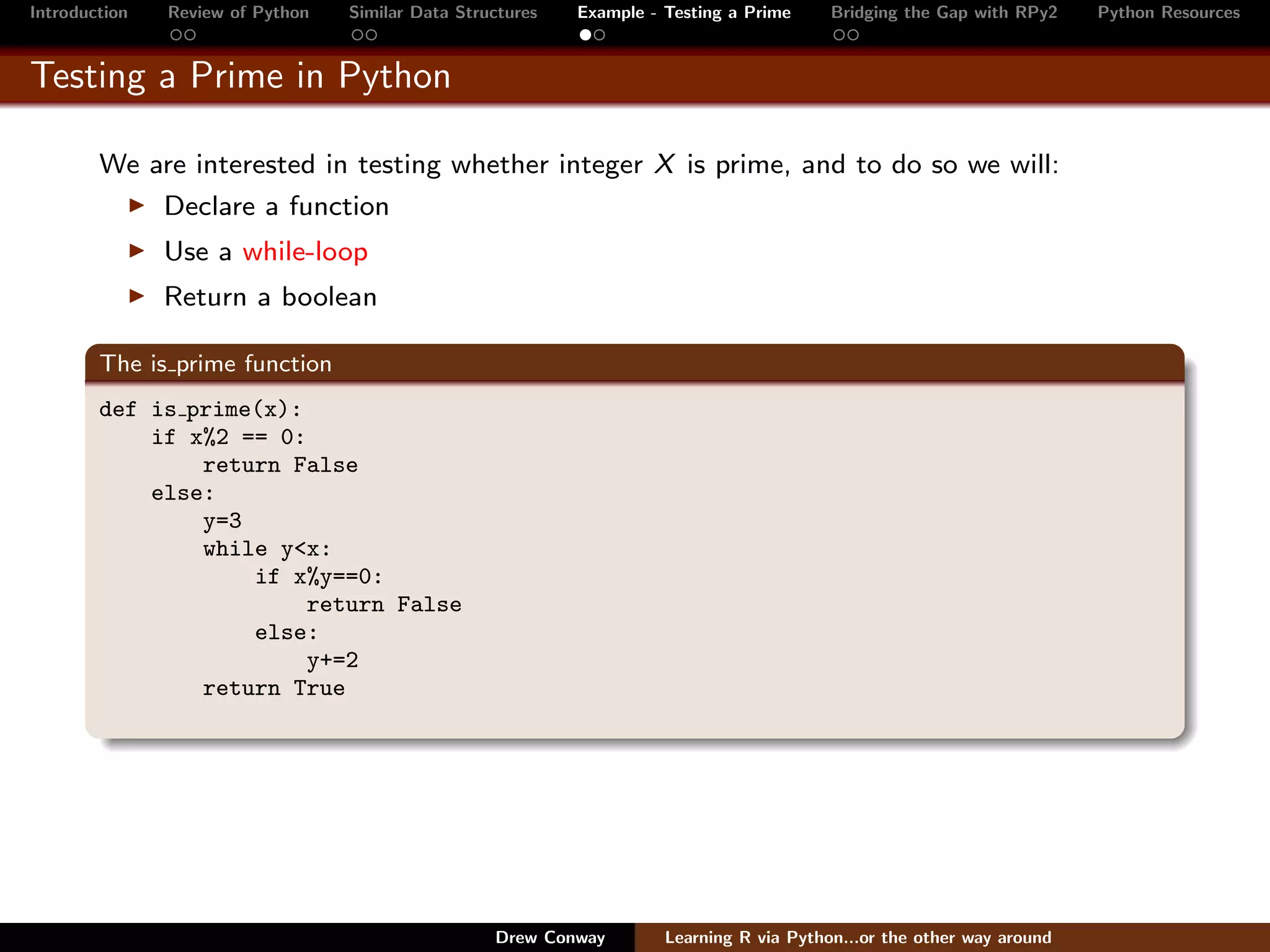
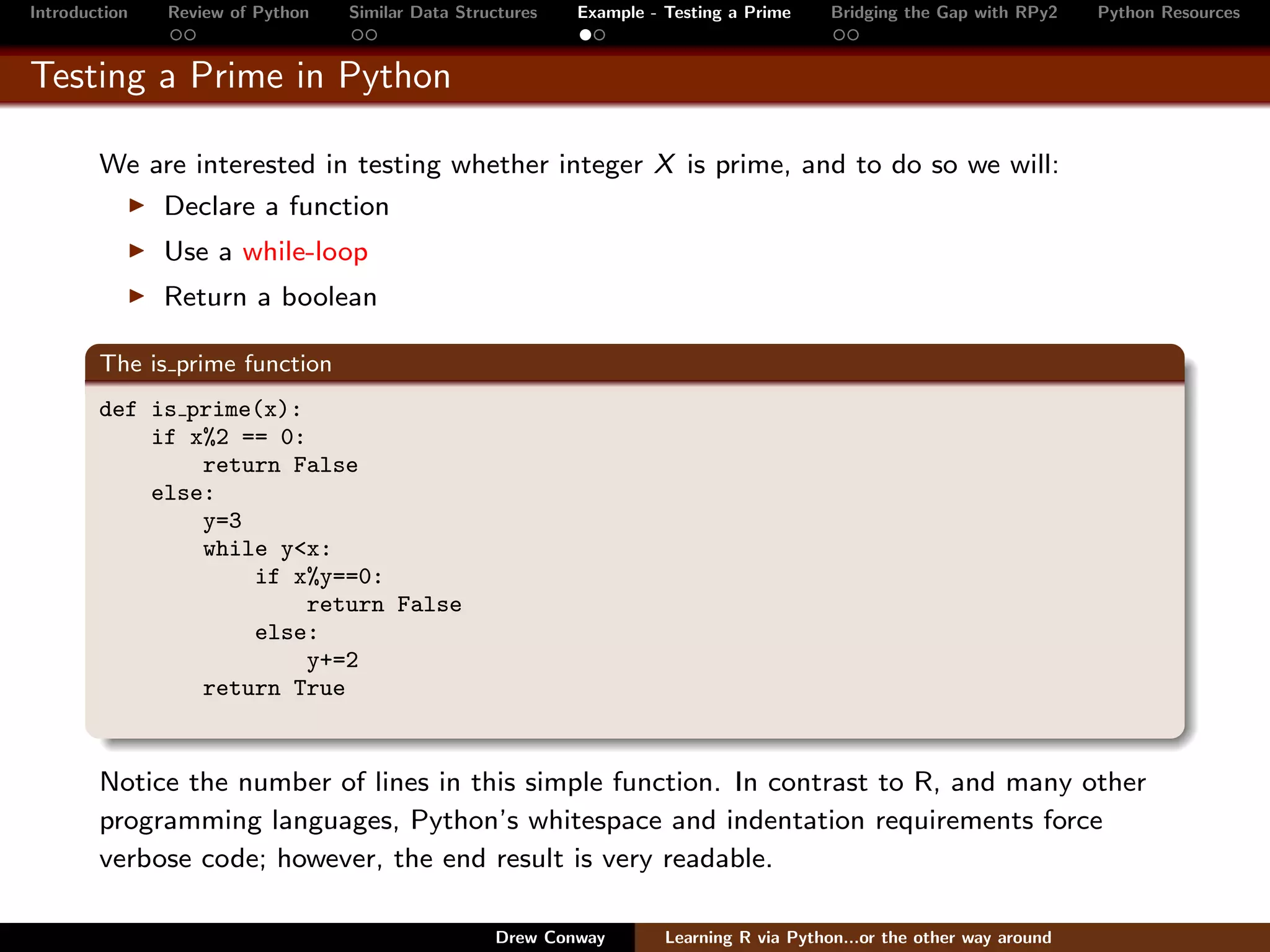
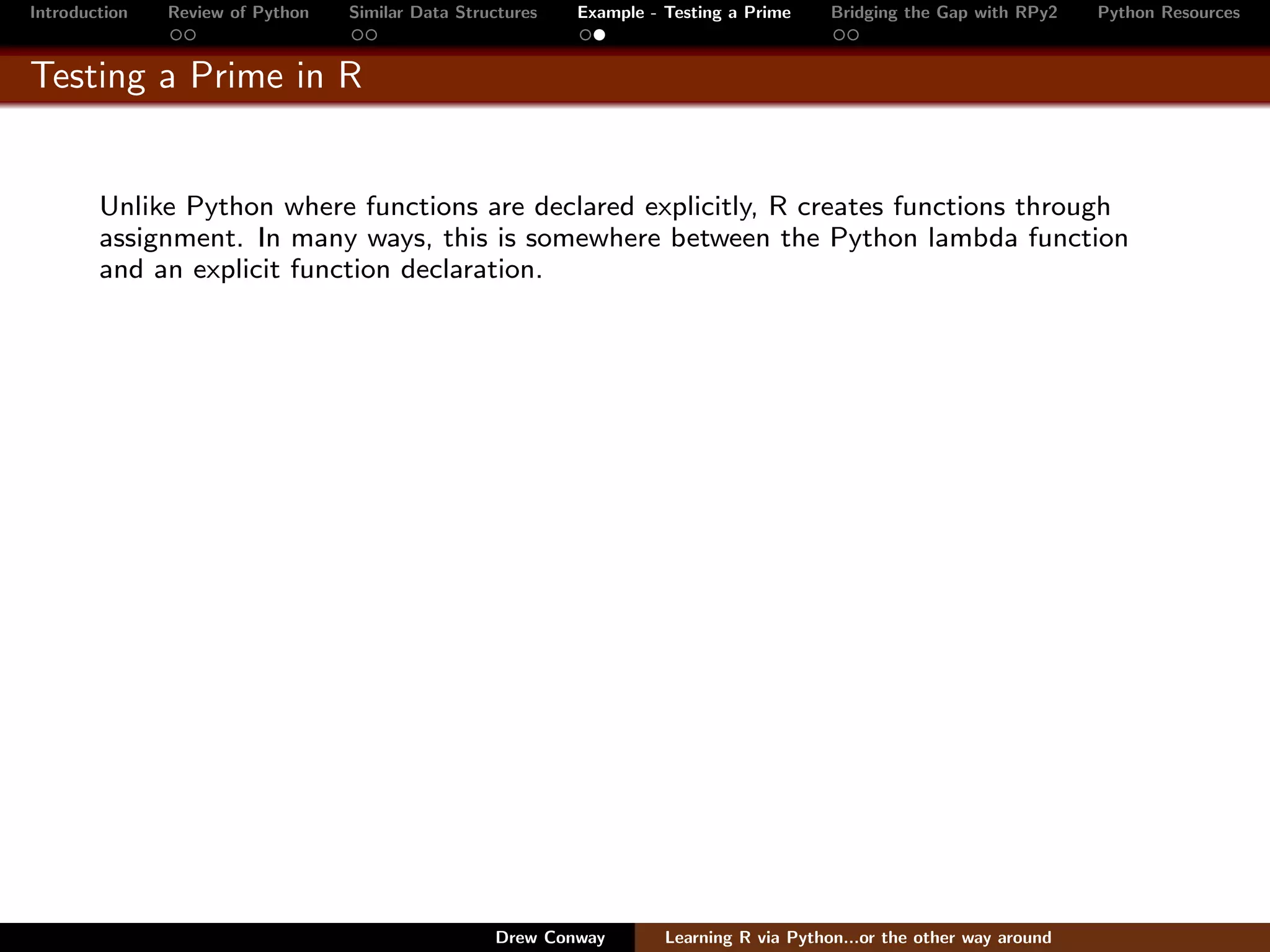
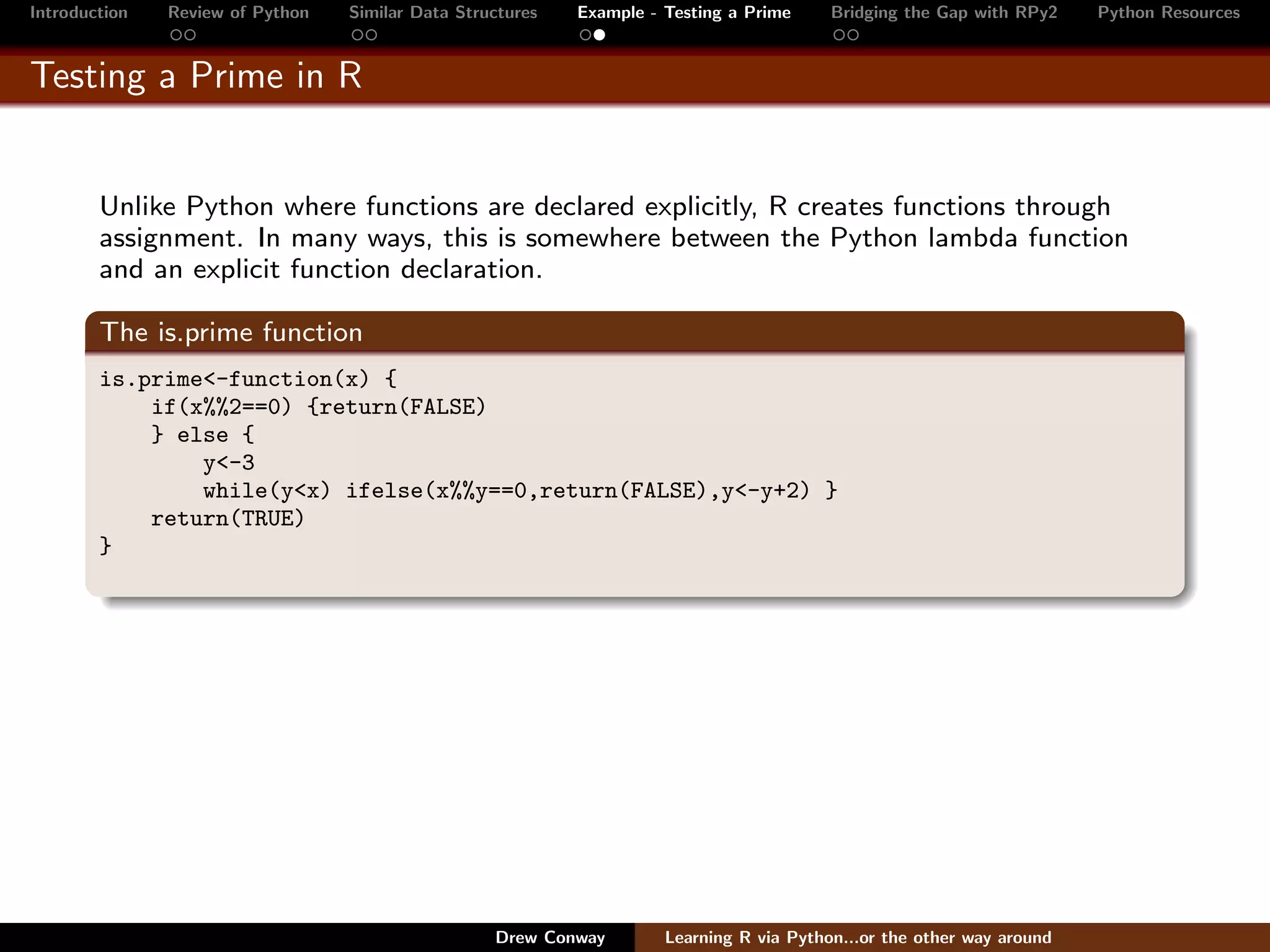
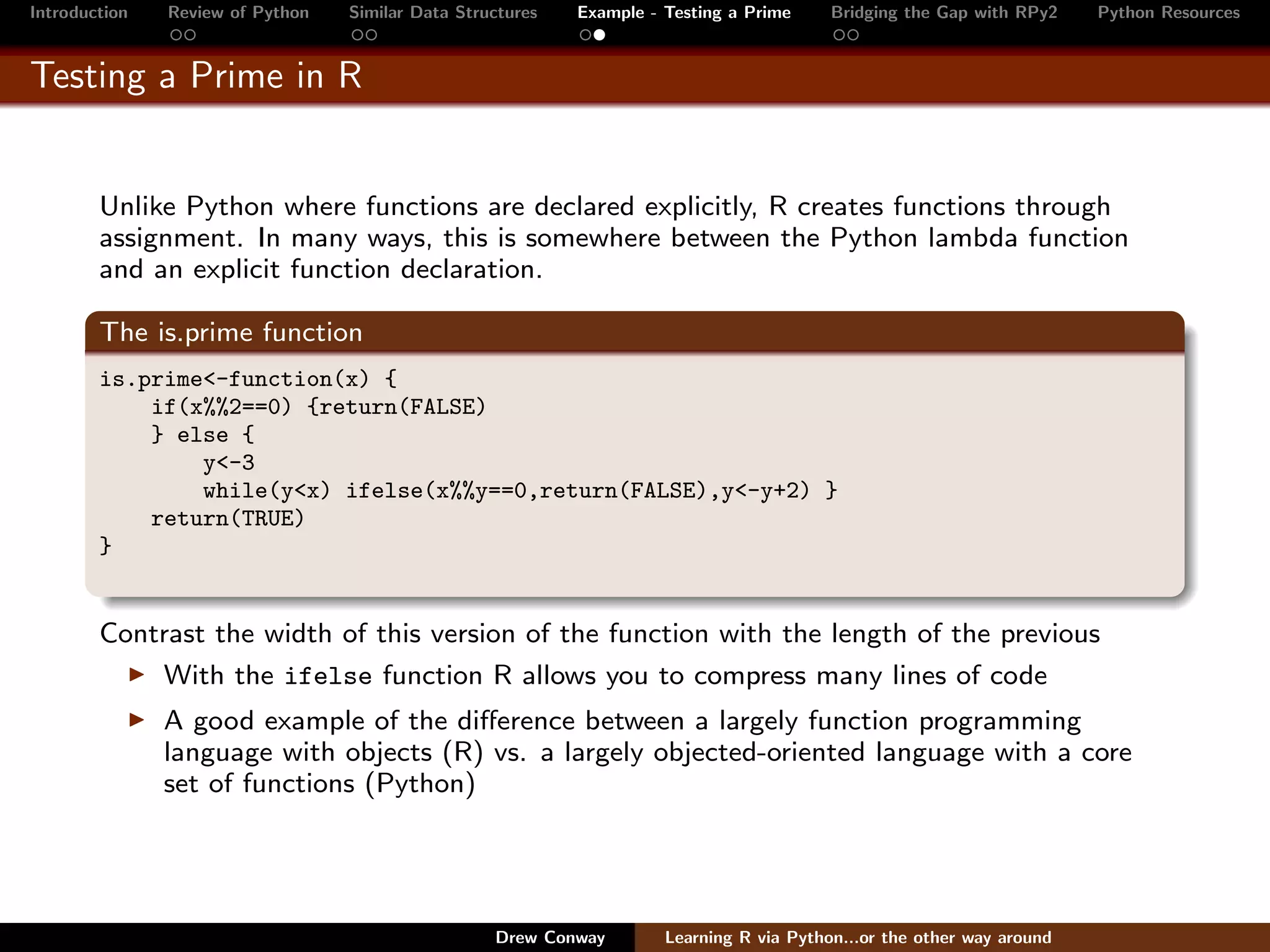
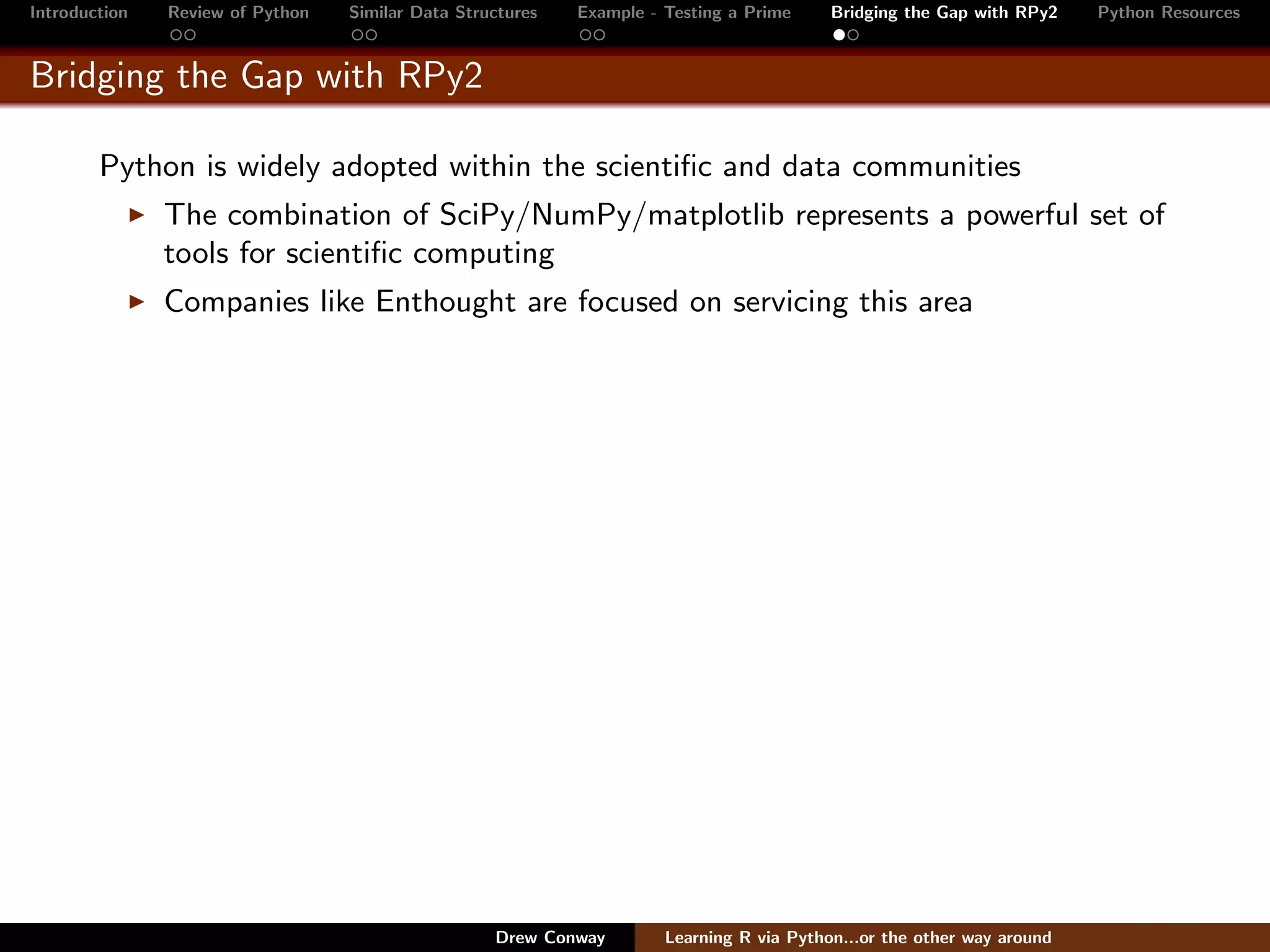
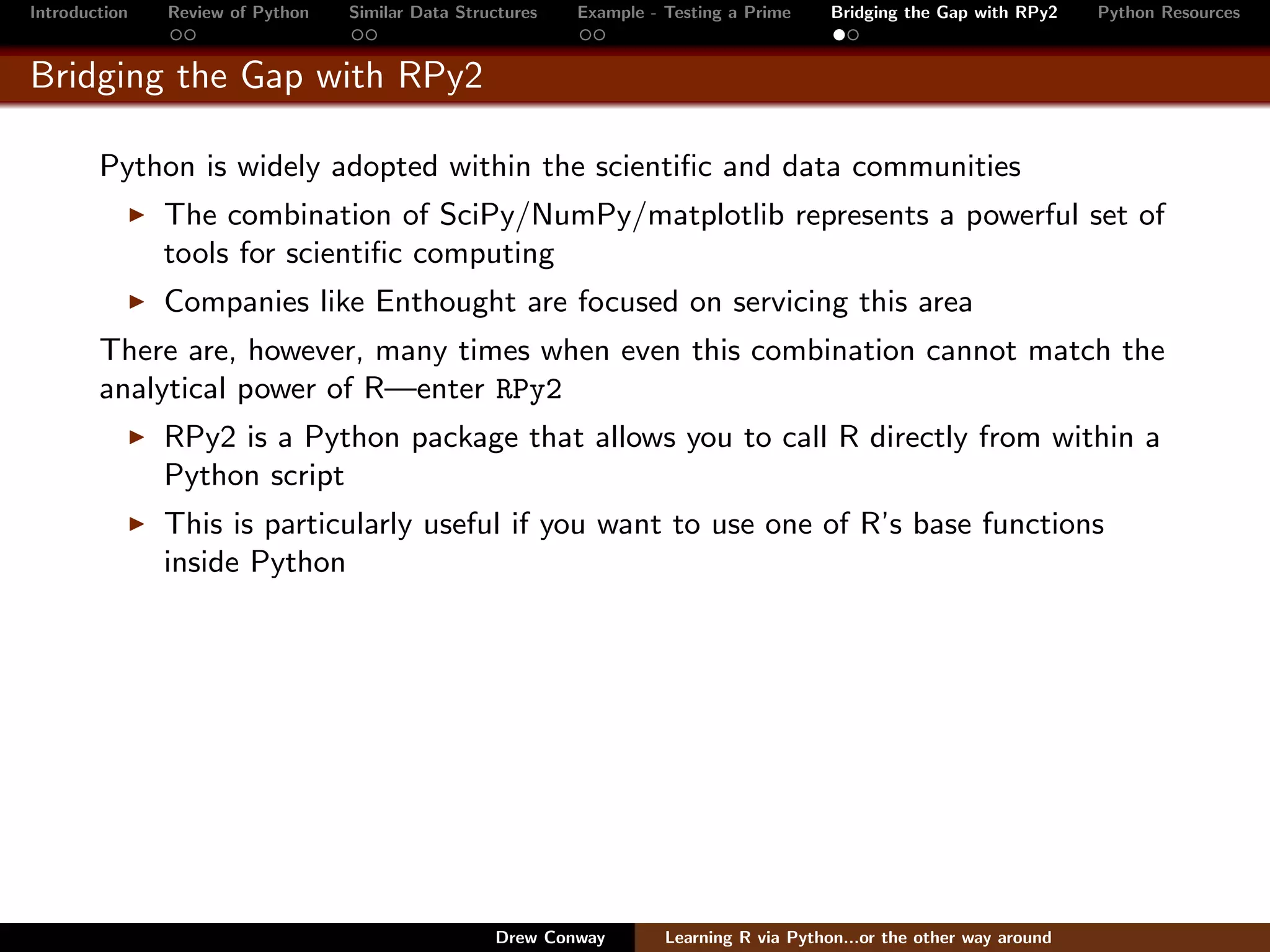
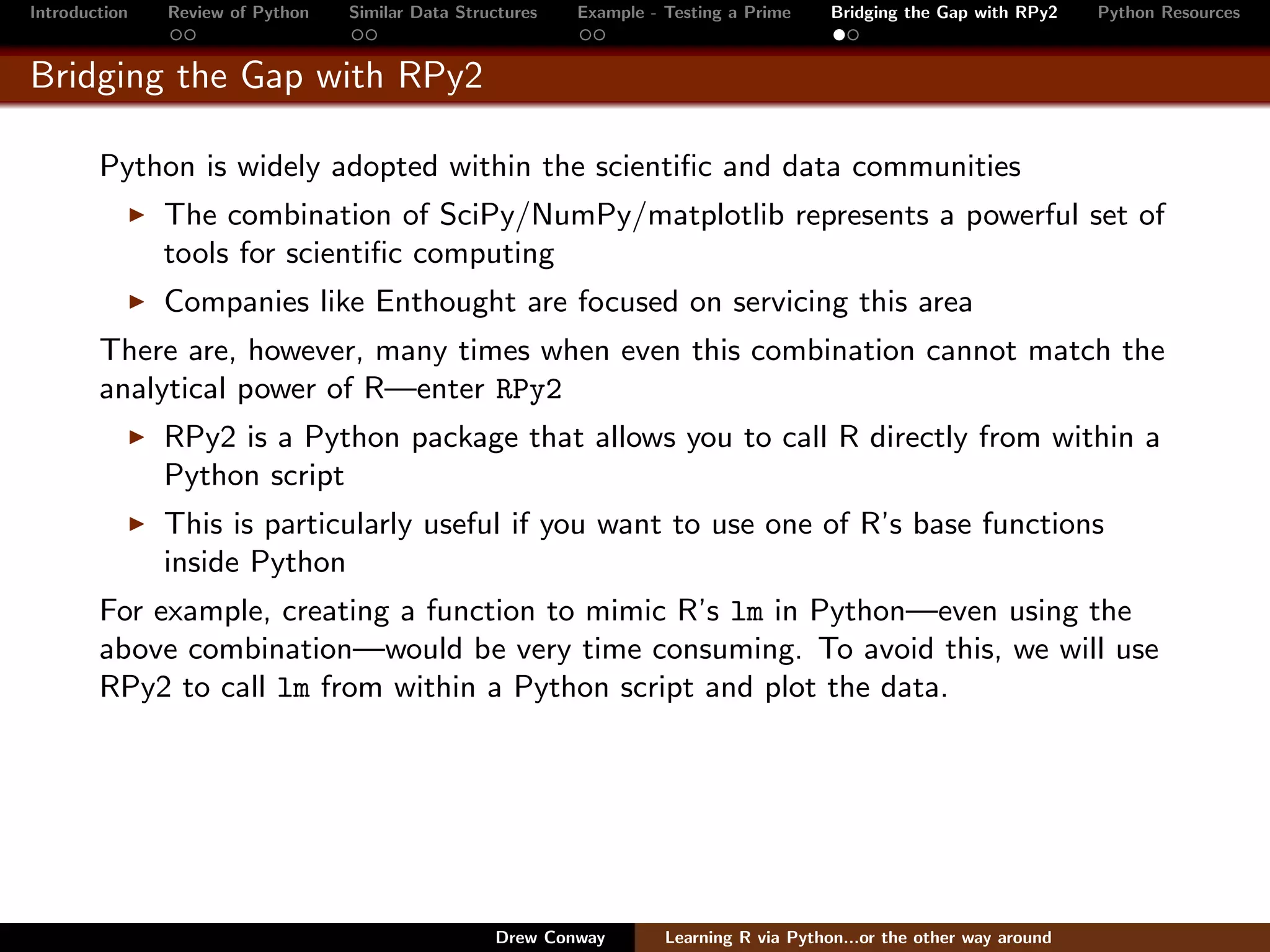
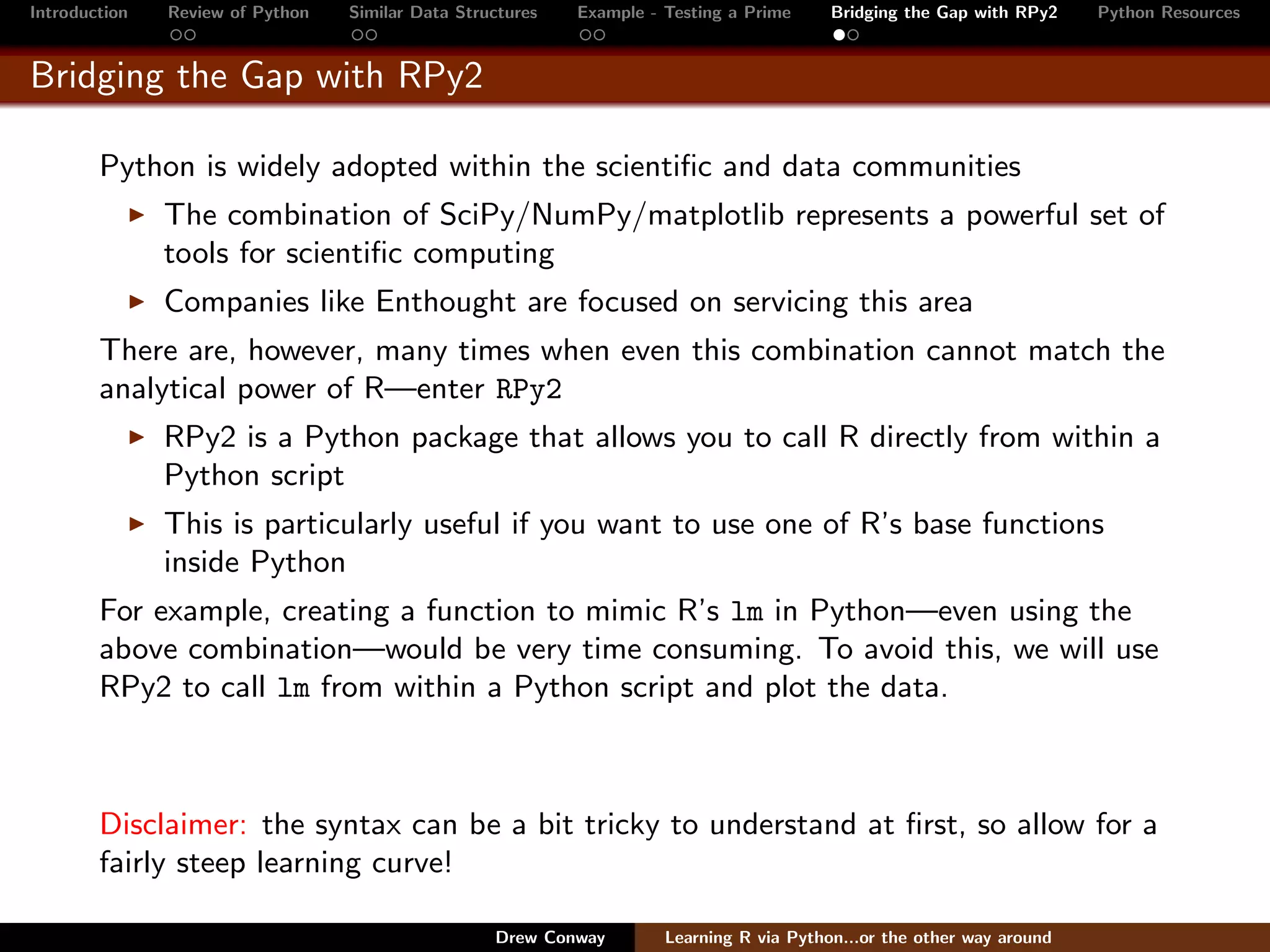
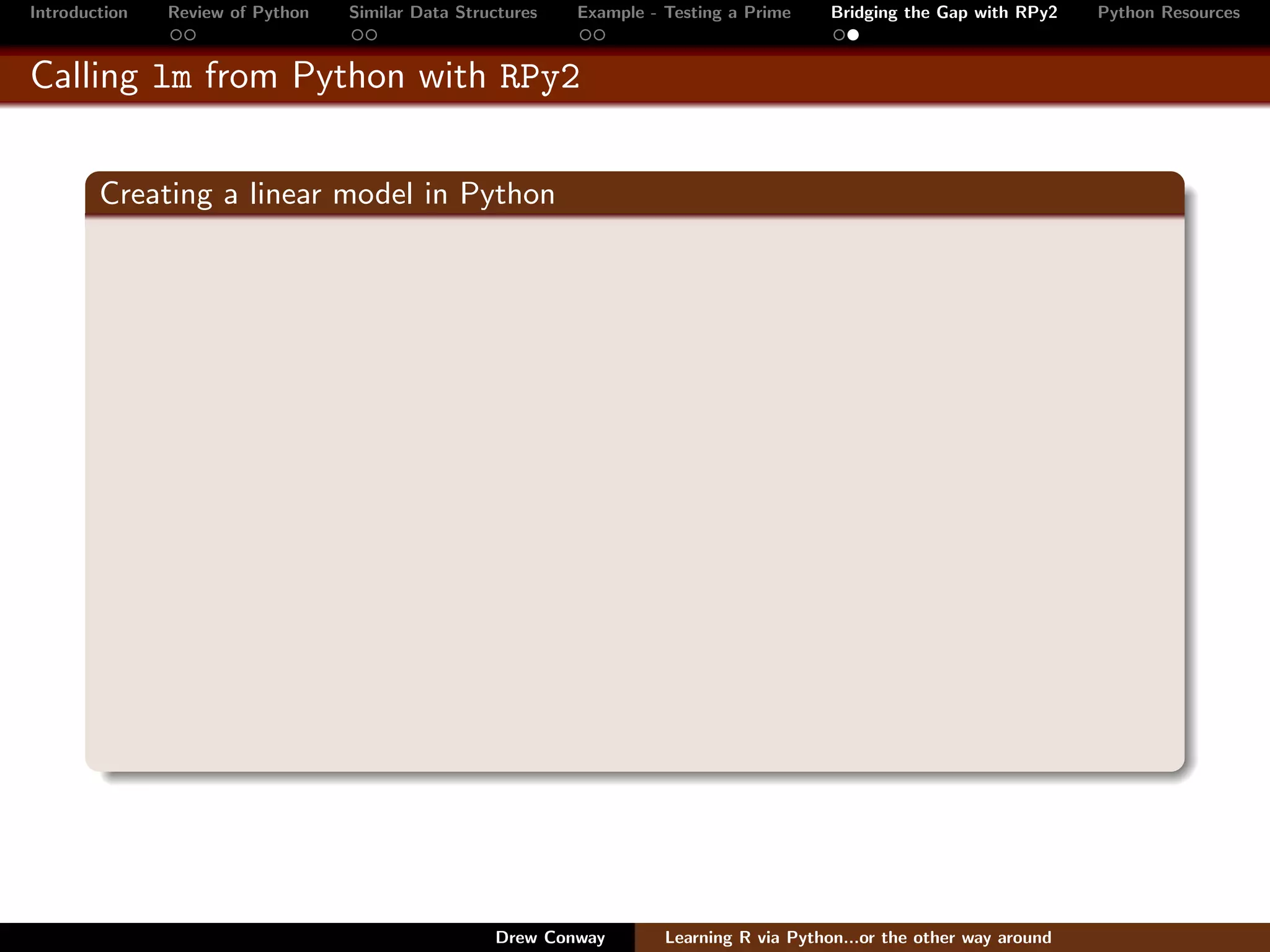
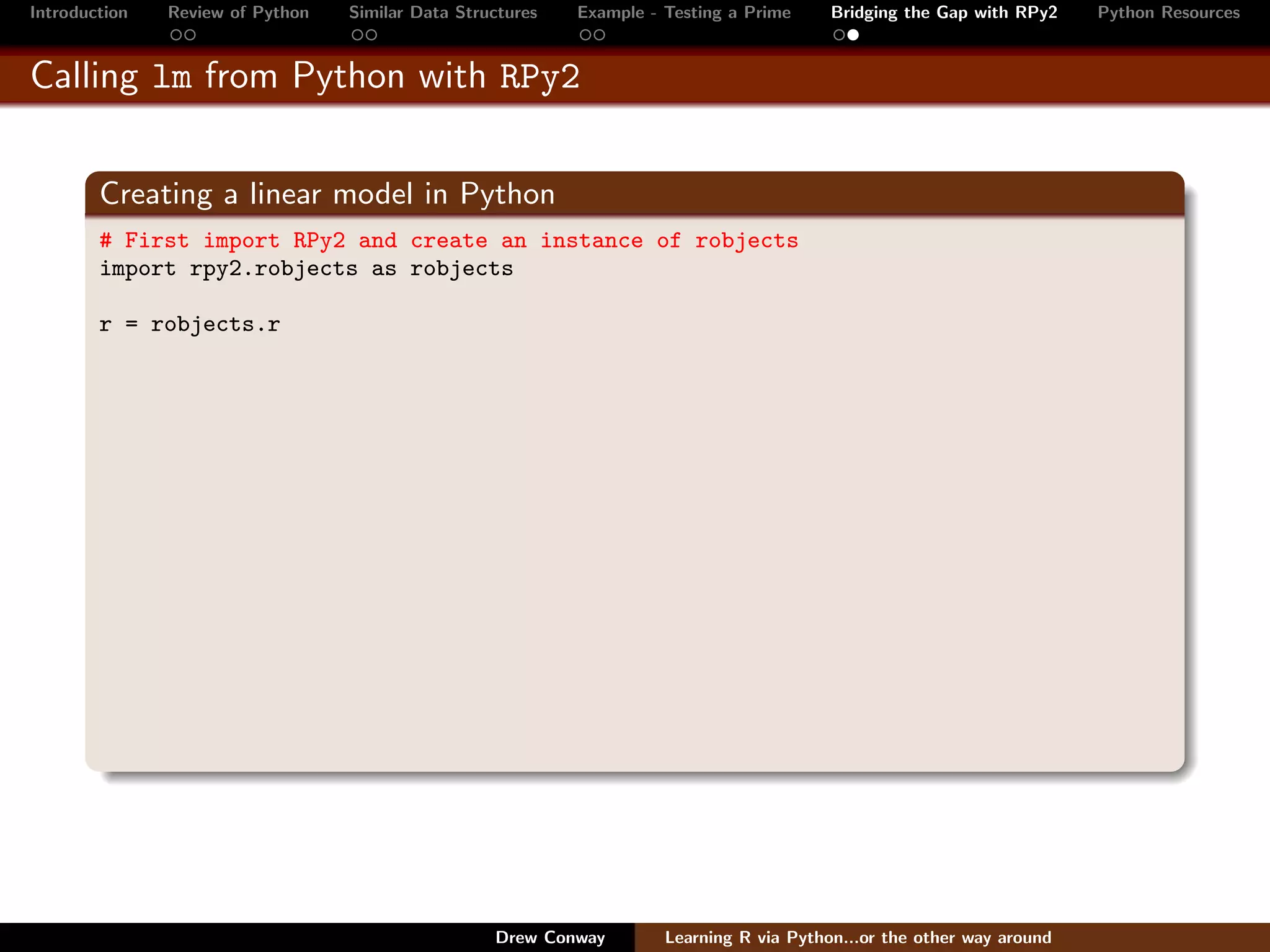
![Introduction Review of Python Similar Data Structures Example - Testing a Prime Bridging the Gap with RPy2 Python Resources
Calling lm from Python with RPy2
Creating a linear model in Python
# First import RPy2 and create an instance of robjects
import rpy2.robjects as robjects
r = robjects.r
# Create the data by passing a Python list to RPy2, which interprets as an R vector
ctl = robjects.FloatVector([4.17,5.58,5.18,6.11,4.50,4.61,5.17,4.53,5.33,5.14])
trt = robjects.FloatVector([4.81,4.17,4.41,3.59,5.87,3.83,6.03,4.89,4.32,4.69])
group = r.gl(2, 10, 20, labels = ["Ctl","Trt"])
weight = ctl + trt
Drew Conway Learning R via Python...or the other way around](https://image.slidesharecdn.com/pythonrrs-110318195139-phpapp02/75/Learning-R-via-Python-or-the-other-way-around-36-2048.jpg)
![Introduction Review of Python Similar Data Structures Example - Testing a Prime Bridging the Gap with RPy2 Python Resources
Calling lm from Python with RPy2
Creating a linear model in Python
# First import RPy2 and create an instance of robjects
import rpy2.robjects as robjects
r = robjects.r
# Create the data by passing a Python list to RPy2, which interprets as an R vector
ctl = robjects.FloatVector([4.17,5.58,5.18,6.11,4.50,4.61,5.17,4.53,5.33,5.14])
trt = robjects.FloatVector([4.81,4.17,4.41,3.59,5.87,3.83,6.03,4.89,4.32,4.69])
group = r.gl(2, 10, 20, labels = ["Ctl","Trt"])
weight = ctl + trt
# RPy2 uses Python dictionary types to index data
robjects.globalEnv["weight"] = weight
robjects.globalEnv["group"] = group
Drew Conway Learning R via Python...or the other way around](https://image.slidesharecdn.com/pythonrrs-110318195139-phpapp02/75/Learning-R-via-Python-or-the-other-way-around-37-2048.jpg)
![Introduction Review of Python Similar Data Structures Example - Testing a Prime Bridging the Gap with RPy2 Python Resources
Calling lm from Python with RPy2
Creating a linear model in Python
# First import RPy2 and create an instance of robjects
import rpy2.robjects as robjects
r = robjects.r
# Create the data by passing a Python list to RPy2, which interprets as an R vector
ctl = robjects.FloatVector([4.17,5.58,5.18,6.11,4.50,4.61,5.17,4.53,5.33,5.14])
trt = robjects.FloatVector([4.81,4.17,4.41,3.59,5.87,3.83,6.03,4.89,4.32,4.69])
group = r.gl(2, 10, 20, labels = ["Ctl","Trt"])
weight = ctl + trt
# RPy2 uses Python dictionary types to index data
robjects.globalEnv["weight"] = weight
robjects.globalEnv["group"] = group
# Run the models
lm_D9 = r.lm("weight ~ group")
print(r.anova(lm_D9))
lm_D90 = r.lm("weight ~ group - 1")
print(r.summary(lm_D90))
Drew Conway Learning R via Python...or the other way around](https://image.slidesharecdn.com/pythonrrs-110318195139-phpapp02/75/Learning-R-via-Python-or-the-other-way-around-38-2048.jpg)
![Introduction Review of Python Similar Data Structures Example - Testing a Prime Bridging the Gap with RPy2 Python Resources
Calling lm from Python with RPy2
Creating a linear model in Python
# First import RPy2 and create an instance of robjects
import rpy2.robjects as robjects
r = robjects.r
# Create the data by passing a Python list to RPy2, which interprets as an R vector
ctl = robjects.FloatVector([4.17,5.58,5.18,6.11,4.50,4.61,5.17,4.53,5.33,5.14])
trt = robjects.FloatVector([4.81,4.17,4.41,3.59,5.87,3.83,6.03,4.89,4.32,4.69])
group = r.gl(2, 10, 20, labels = ["Ctl","Trt"])
weight = ctl + trt
# RPy2 uses Python dictionary types to index data
robjects.globalEnv["weight"] = weight
robjects.globalEnv["group"] = group
# Run the models
lm_D9 = r.lm("weight ~ group")
print(r.anova(lm_D9))
lm_D90 = r.lm("weight ~ group - 1")
print(r.summary(lm_D90))
For more info check out the RPy2 documentation (from where this example
was stolen!)
Drew Conway Learning R via Python...or the other way around](https://image.slidesharecdn.com/pythonrrs-110318195139-phpapp02/75/Learning-R-via-Python-or-the-other-way-around-39-2048.jpg)
